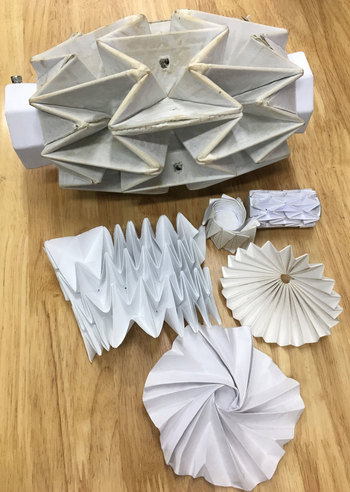Department News
Prof. Kyu-Jin Cho [The Hankyoreh] No Mechanical Parts Needed: Origami Transforms Robotics
No Mechanical Parts Needed: Origami Transforms Robotics<?xml:namespace prefix = "o" ns = "urn:schemas-microsoft-com:office:office" />
[Future&Science]
Foldable Structure Replacing Machine
Smaller, Lighter, Simpler Robots
Wheel Robot Changes Its Size
Flea Robot Folds Itself and Jumps
Robot Arm Expands and Shrinks
Solar Cells Unfolds Like an Umbrella
Various Applications Including Medicine and Space Exploration
An Entirely New Concept of ‘Robot’
Korean Researchers Producing Successful Results
Robot that mimics the jumping movement of a water strider using origami-inspired structure. Upon contact with heat, the shape memory alloy (SMA) of the robot’s lower body shrinks, enabling the robot to kick the water’s surface and jump. Photo by SNU-Harvard joint research team
On April 18, upon visiting the Soft Robotics Research Center in Building 301 of Seoul National University’s College of Engineering, we could observe folded paper models scattered all over the desks. Researchers, many of whom are graduate students, are currently designing and developing a new type of robot, inspired by the art of origami. Dr. Dae-Young Lee, a postdoctoral researcher, introduced himself as a ‘robotics engineer getting inspirations from origami.’ “Yeah, some people say it looks like a toy design lab. But it’s an entirely new type of toy, designed on a single flat surface and manufactured without any bolts or nuts.”
In one corner of the Center, robots resembling inchworms, fleas, and water striders greet the visitors. These robots might be smaller than your finger, but they have garnered immense attention from the international scientific community. The water strider robot was published on Science in 2015.

Deformable wheel robot using origami folding patterns. Photo by SNU Soft Robotics Research Center
“Foldable Structure Replaces Mechanical Parts, Making the Robot Simpler”

Origami mock-ups from the development of deformable wheel robot. Photo by Cheolwoo Oh
At first glance, origami robots seem weakly structured just like paper and limited in movement. Why are engineers so interested in this? Professor Kyu-Jin Cho (Mechanical Engineering), Director of SRRC, explains that origami-inspired robot research is “something that can change the very concept of a robot.” The image of robots we typically imagine is a complicated machine consisting of numerous different parts. “With robots like that, there’s a limit to how much they can be reduced in size. As mechanical parts like bolts, nuts, and joints get smaller, it gets more difficult to deal with friction. But we can get rid of mechanical parts by using folding patters on a single flat surface, borrowed from origami principles.” In a way, origami-inspired robotics engineering is a ‘conceptual’ research, studying how a complex machine can be simplified and to what extent.
The deformable wheel is one such example. It expands when climbing over obstacles and shrinks when squeezing under low ceilings. At the start of the research, the team thought of controlling the wheel with multiple actuators. But the machine got too complicated. “At first we used 16 actuators to make the wheel expand and shrink, which wasn’t easy. Origami provided the solution,” said Prof. Cho. The wheel that can change size using origami principles can operate with just one actuator.
......
Prof. Cho commented as follows: “Robotics engineering doesn’t directly apply origami principles; we don’t use paper or follow traditional rules of origami. But it’s a great source of inspiration for an engineer who wants to create a small, light, and simple machine. In origami, a single flat surface can be folded in different ways to be flexible or strengthened. Two-dimensional material can become a three-dimensional structure. It also shrinks and expands. So we can imagine printable robots, or robots that can be folded flat in storage and unfolded when in use. Origami robotics seeks to explore a completely different concept of what a robot is.”
Jun-seo Lee, Director of Administration at Korea Paper Culture Foundation, an organization that aims to discover, conserve, and promote Korean paper culture, added that “jongi jupgi (origami) is part of our traditional culture” and that “Seung-kyung-do, a board game from late Goreyo and early Joseon periods, was also made to be unfolded when both sides of the plane were pulled at once.”
Cheolwoo Oh, Senior Reporter cheolwoo@hani.co.kr
Link to article:
http://www.hani.co.kr/arti/science/technology/841625.html#csidx2b05b9020a9093ba1295e5dbdc7f68d

